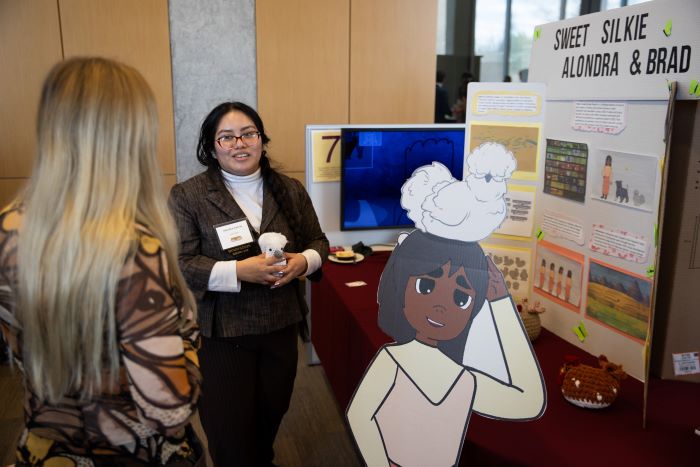
Start up
Passion. Potential. Pitches. Don't miss any of the 2025 New Venture Challenge excitement.
Tune in Friday, April 11 at 1 p.m. for great ideas and fierce competition. Then, join the judges, mentors, spectators and teams as they see who is going home with thousands of dollars in venture financing. The awards broadcast begins at 6:30 p.m. and one team will walk away as the overall best venture.
Central Michigan University’s College of Business Administration is the home of the Isabella Bank Institute for Entrepreneurship and the first Department of Entrepreneurship in the state of Michigan. We are a student-centric hub where experiential, curricular, and external entrepreneurial opportunities intersect.
Our mission is to maximize student success by fostering a campus-wide entrepreneurial mindset that promotes inter-disciplinary collaboration and the creation of new ventures.
We aim to create innovative programming, boost cross-campus and ecosystem collaboration and provide a comprehensive mentoring program.
Our institute provides extracurricular opportunities and is open to all undergraduate and graduate CMU students.
Are you interested in becoming an entrepreneur?
Every journey is unique. Explore the opportunities that interest you.
Mosquitoes are an unfortunate part of every Michigan summer. They can ruin a picnic faster than ants and can chase the most serious outdoor enthusiasts back indoors. They also carry viruses that can spread diseases, collectively referred to as arboviruses.
Dr. Nicholas Haddad, a doctor specializing in internal medicine and infectious disease with Central Michigan University’s College of Medicine, explained what they are and what you can do to avoid catching them.
Q: What is an arbovirus?
Arboviruses are viruses carried by insects or ticks. They cause disease when the insects carrying them bite humans or animals. These infections occur during the warm months when insects are most active.
Q: What is the most common arbovirus disease and why?
The most common arboviral infection in the United States is West Nile Virus (WNV), which is carried by the common mosquito (Culex species). For example, in 2020 there were 731 cases of WNV, 559 of which were very severe, spreading to the brain or spinal cord. Those data are from 2020, which is the most recent information reported to the CDC by 44 states. Other arboviruses caused disease in humans in much lower numbers in 2020: La Crosse (88 patients), Powassan (21 patients), St. Louis encephalitis (16 patients), Eastern Equine Encephalitis (13 patients), Jamestown Canyon (13 patients), and California Encephalitis (2 patients).
Q: Which is the most dangerous and why?
Most of those viral infections can be dangerous. As their name implies, they may cause encephalitis, which is inflammation of the brain due to spread of the virus to the central nervous system. By virtue of WNV being the most common and causing neuroinvasive disease in 559 of 731 (76%) patients in 2020, it is the most dangerous. Of the WNV infected patients in 2020, a total of 583 (80%) patients were hospitalized, and 66 (9%) died. Of the other arboviruses, Eastern Equine Encephalitis (EEE) is the most severe, causing around 30% death in infected individuals. Luckily, it caused infection only in 13 patients in 2020 so it is much less common than WNV.
Q: What symptoms might tell someone they’ve contracted a disease?
Symptoms from arboviral infections vary between mild and severe. Most patients have headache and fever, which should indicate to health care providers that a CNS infection is likely. Mild symptoms include muscle aches, skin rash. Severe symptoms include high grade fever, severe headache, that progresses to confusion, seizures, paralysis, loss of consciousness and ultimately death in some patients. Incubation period is 3-14 days depending on the type of arboviral infection. This period is the time between the insect bite that transmits the virus, to the onset of clinical symptoms.
Q: When should someone seek medical care?
Patients who develop high-grade fever, severe headache, especially if there is confusion associated with those symptoms, should be promptly seen in the emergency department. Mild symptoms such as low-grade fever (<100), mild headache, faint rashes, especially if the patient continues to feel well, can be monitored closely and do not need to be promptly evaluated.
Q: How to prevent arboviral infections?
Application of insect repellants when outdoor is an important means of preventing insect bites. Information on repellants can be found here: https://www.epa.gov/insect-repellents
Other tricks are to cover skin with clothing, such as tucking shirts under pants, and pants in socks, so insects and ticks have no access to your skin to bite. Wearing light colored clothes also helps spot insects and ticks more easily.
Other means for prevention include:

Dr. Nicholas Haddad teaches at the CMU College of Medicine/Internal Medicine Residency Program. He received his medical degree from the American University of Beirut, did his residency at the Indiana University School of Medicine and did a fellowship in infectious diseases at Washington University.

Explore special opportunities to learn new skills and travel the world.

Present your venture and win BIG at the New Venture Challenge.

Boost your entrepreneurial skills through our workshops, mentor meetups and pitch competitions.

Learn about the entrepreneurship makerspace on campus in Grawn Hall.

Present a 2-minute pitch at the Make-A-Pitch Competition and you could win prizes and bragging rights!

Connect with mentors and faculty who are here to support the next generation of CMU entrepreneurs.

Are you a CMU alum looking to support CMU student entrepreneurs? Learn how you can support or donate to the Entrepreneurship Institute.